Climb the Cascades Fundraiser: Mt. Hood Trip Report (Volcano 2/5)
This trip supported my 2022 Adventure Fundraiser for The Cairn Project. I climbed 5 volcanic peaks to raise grant funding for female youth-serving organizations to expand access to outdoor learning and experiences! This was the donation page.
And big thanks to LOWA boots for supporting the mission! I adore my Alpine Expert pair that I wore on this climb.
Mt. Hood Summit via The Old Chute: June 30, 2022

Behind me is a view north featuring Mount St. Helens (left), Mt. Rainier (center) and Mt. Adams (right).
The Backstory
I’ve stared at towering Mt. Hood nearly every day for over 5 years now, but, despite my alpine wishes, it took me that long to finally stand at its top!
As Oregon’s highest point, Hood is a popular climb. But the south side route to the summit– the most climbed route– requires a good bit of critical thinking and risk management. Because of certain hazards on the mountain– as well as the fact that every year brings climber injury/death– I wanted my first summit attempt to be with partners I trusted and who’d climbed it before. It proved tricky to find trusted buddies to climb with me, so Hood remained on the backburner as I continued to build experience on peaks like Adams and St. Helens. I finally caved and decided that I’d join a guided group climb for my first experience.
My intention for climbing Mt. Hood as a part of my Adventure Fundraiser was to attempt a peak in the region that’s a bit more technical and/or hazardous than I’ve climbed before. I sought to do that in a way that I’d understand how to mitigate my risk on this peak and know that I could return myself or with a climbing partner and feel comfortable without a guide.

Headed up Mt. Hood at dawn.
The Ascent
We wanted to get an early start since summer conditions were starting to set in, and it can get more hazardous as the day warms up. We were on foot (no skis), so we wanted pretty firm snow for most of the climb. We started at about 1AM at Timberline Lodge and started up the ski resort. The first two miles of the route are simply a cat track to the top of the Palmer Lift. They do nightly snow farming on the mountain (bringing snow down from the upper mountain for lower elevation ski trails), so it was easy walking on groomed trail. For miles, you could hear the vehicles and equipment moving and beeping– it didn’t feel like the backcountry! Plus, you could still see the lights of Timberline Lodge below, so it felt extremely frontcountry for the entire climb, which was a bit surprising to me.
In those early hours, it was pitch black with a new moon. I couldn't see any features around me– not even a silhouette– and was very curious to imagine what it would look like in a few hours on our way back down. All we could do was slowly put one foot in front of the other and walk up the track. I cherish those magical pre-dawn hours when you can walk quietly with your thoughts; I find a lot of inspiration in my brain when the world is asleep.
Once we got to the top of Palmer, we put on crampons for added traction on the ice (it was hovering around freezing), but kept our ice axes stowed. We continued at the easy pace, which honestly felt too slow for me. Had I gone at my natural climbing pace, I think I would’ve gone round-trip in half the time. My heart rate didn’t get higher than 153 bpm, which is what I hit on an easy run. I remember thinking how much easier climbing Hood felt compared to Adams or St. Helens, but that’s possibly (or probably) due to going a much slower pace than usual. (Of course, this was expected from joining a group climb.)

First bits of light on the ascent of Mt. Hood.
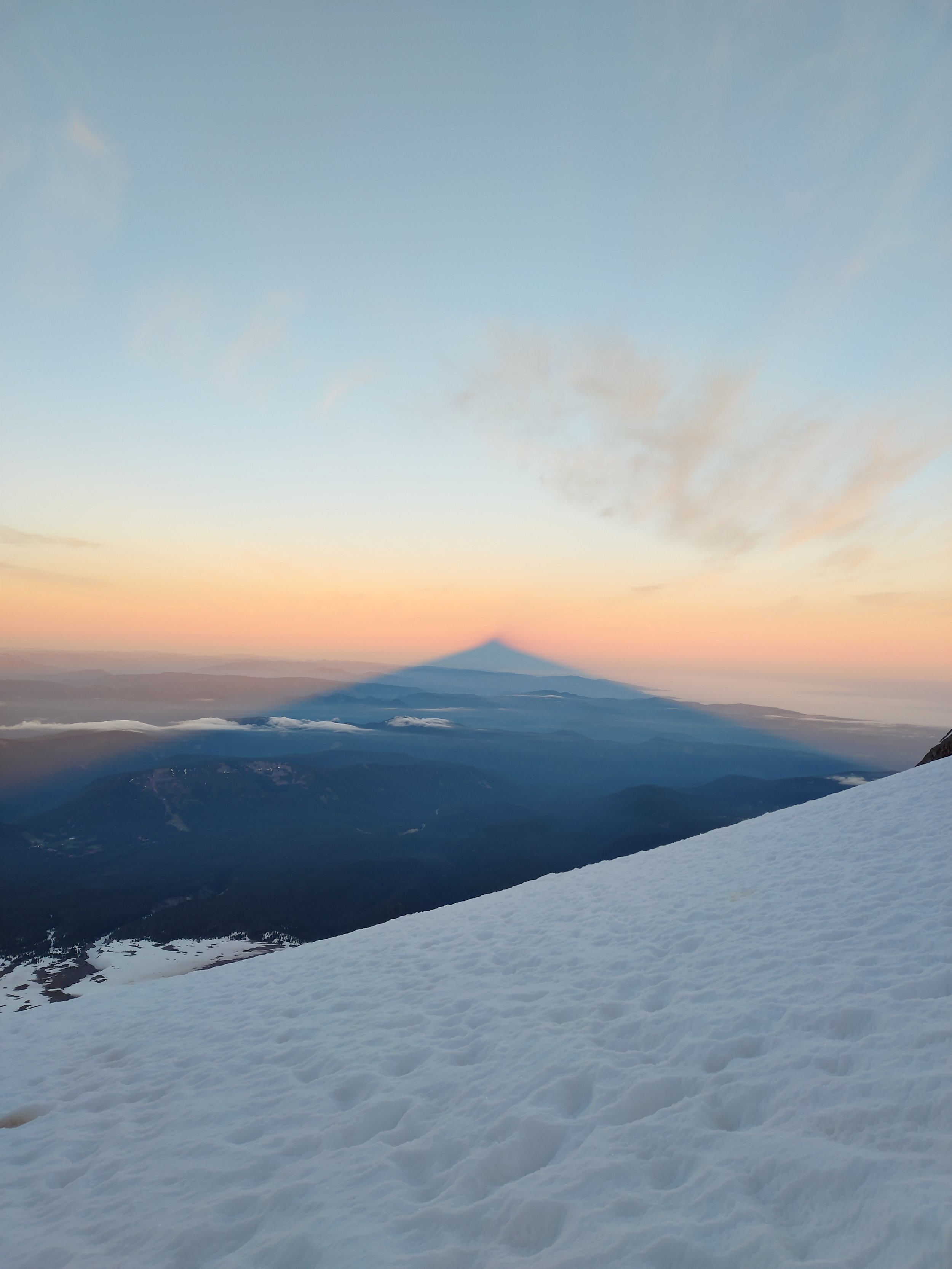
I had excellent weather and views for my first climb of Hood.
As we got up higher on the glacier, we started getting that gorgeous pre-dawn light: soft pastel pink streaked with icy blue and tinges of pale gold. It illuminated the features of the upper mountain as well as the landscape stretching for hundreds of miles around us. Much more to look at than just my feet under a headlamp!
Long before reaching the crater, we were greeted with scents from fumaroles, and continued to smell volcanic gasses for much of the climb. The sun continued to rise, but we weren’t directly exposed to rays yet; we just got to enjoy the shadow of the mountain and the world waking up from above. Soon, we reached the Devil's Kitchen.
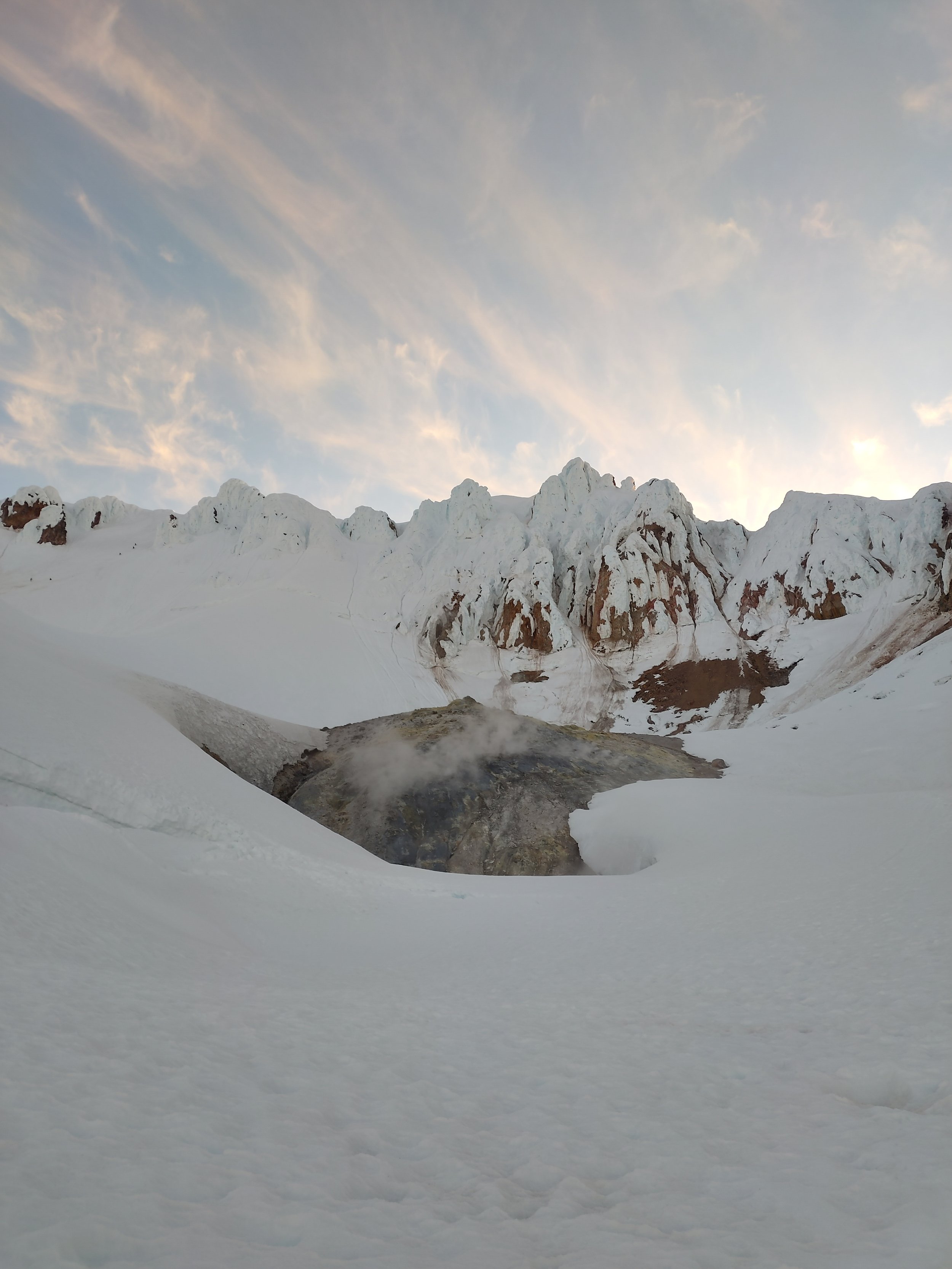
The stinky and hazardous Devil’s Kitchen in the crater. See climbers on the Old Chute at left.
Looking at the upper mountain, it was clear that the Pearly Gates were out for the season. The bergschrund was gaping, with no safe way to navigate to the Gates. The Old Chute had a very clear path up; we just had to be mindful of thin snow bridges between here and there that would probably collapse within days or weeks. Conditions appeared “late season” for sure. We took a bit of a break, then donned our helmets, harnesses and ice axes.
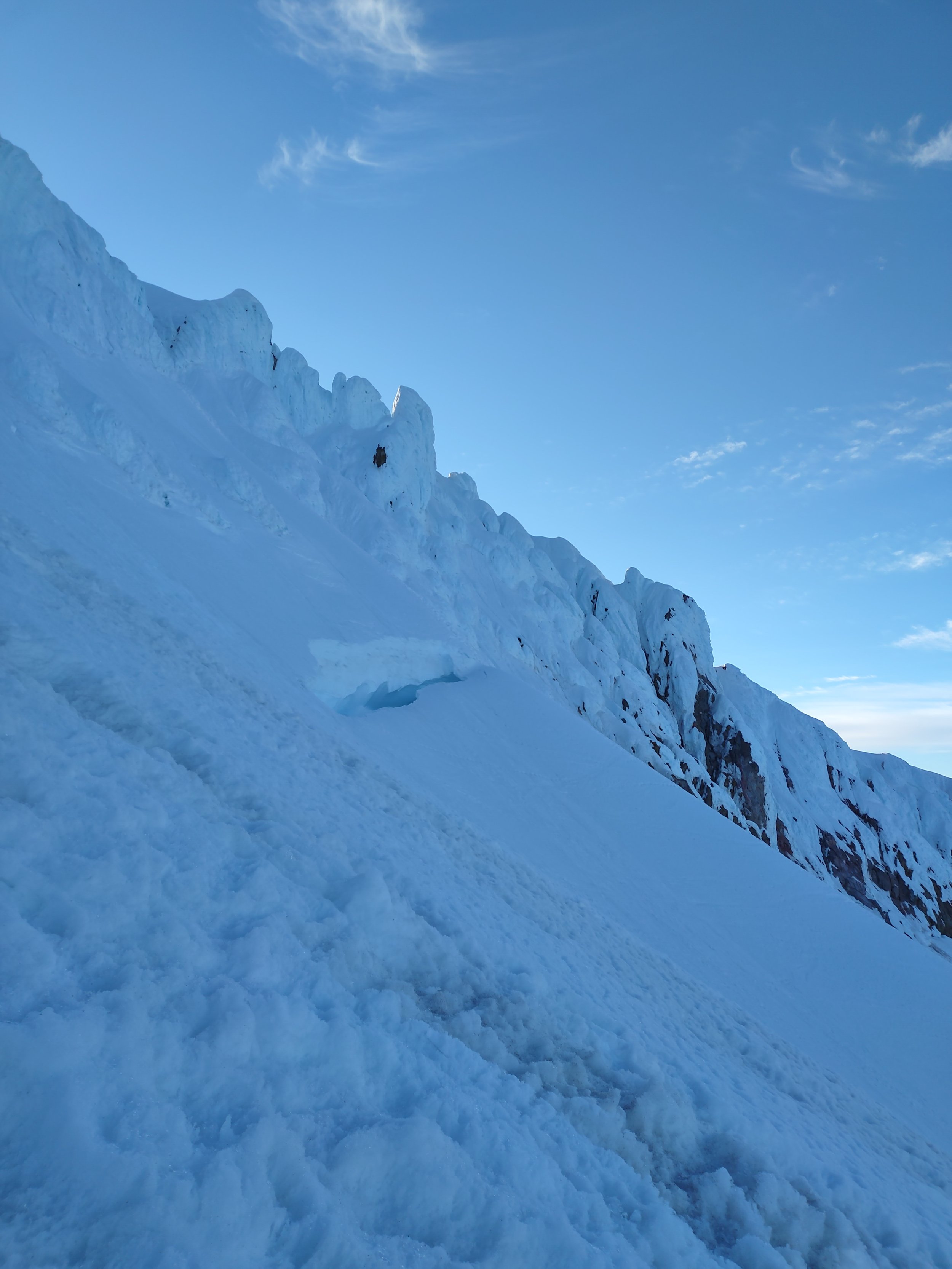
The bergschrund is very open.
Since we wanted to be mindful of weak snow features, growing cracks and slippery ice, we decided to protect against individual falls by roping up. I was on a rope team of three, myself in the back. I found it difficult in the back, since the pace continued to be far slower than I’d normally move, and I didn’t want there to be too much slack in the rope that my partner in front of me would trip. This led me to actually feel quite uneasy on the rope; I felt that I’d have been safe and comfortable unroped and would’ve preferred going up on all fours armed with an ice axe and crampons. Of course, I would’ve been focused and risk-aware since that would also come with hazards, but being on the rope made me super preoccupied with the rope itself and others’ safety, which took away the attention that I would’ve spent on finding stable footing and handholds.
Most groups do not rope up on Mount Hood, which made me question the necessity when I felt less than thrilled about it. However, our guides chose to use ropes up the Old Chute because some climbers didn’t have much practice with self-arrest, and I respected their decision.

Headed up the Old Chute.
So, upward we went! The footing on the way up was pretty precarious. It was a very icy 50 degree slope where you absolutely need to ensure you have traction with each step, or else you could slip and potentially bring down your entire rope team to the hot rocks and Devil's Kitchen. Definitely not a place that you want to take a tumble. I got into the “flow zone” to focus on stable steps and controlled, efficient movement– I live for that kind of focused endurance. Once we topped out on Old Chute, we walked a short traverse across the ridge to get to the true summit under a golden sun. Wooohooo!
The Summit
This could be an unpopular opinion, but… The summit was a bit underwhelming to me. I know it's the top of Oregon, but it just didn't seem like anything I hadn't seen before. I think the views from St. Helens and Adams are just as cool (if not better… let me know if you disagree). One fun aspect was seeing the marine layer; on the west side of the Cascades, there were thick clouds, and on the east side, it was stunningly clear, with a delineation at the crest of the range.
We hung out at the summit for a while, enjoying perfect conditions. For this and the remainder of the trip, it was sunny and clear. We could see Jefferson and the Three Sisters in the south, and Adams, Rainier and St. Helens in the north.

Alpine starts are a sure way to set yourself up for a great rest of the day.

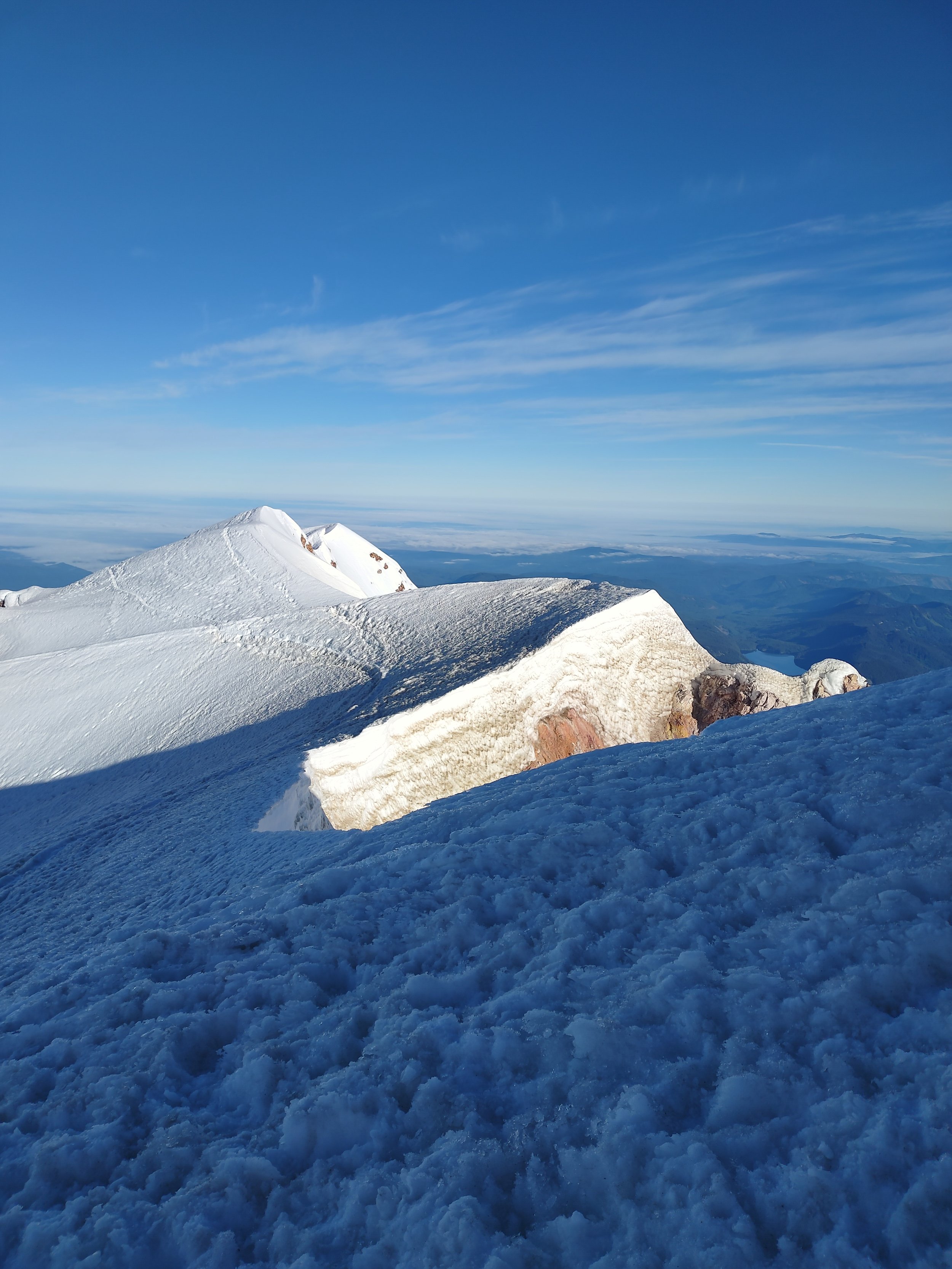
The Descent
When it was time to descend the Old Chute, we roped back up and set a belay system. The concept was that the guide would stay at the top of the rope and the rest of us would belay ourselves down the rope length, and then the guide would downclimb to our anchor. Again, here I would’ve preferred myself going unroped. The belay system made it more difficult for me to move in a way that felt safe and comfortable, especially since I would’ve felt confident downclimbing with just my own body and tools. Believe me, I understand the hazards of downclimbing as well, but I felt stable and focused on the slope and knew how to self arrest. On this particular climb, the rope simply made me uneasy, but we got down with two pitches of belay then walked the rest.

We met back up in the crater where we stripped our helmets and harnesses, stowed our ice axes, and kept our crampons on. It then got very hot under the fully risen sun. I felt quite exposed (boooo, pale skin!) and used a ton of sunscreen. Note to self: Find a solid sun hoodie for the future.
For the initial descent down from the crater, we walked with crampons on during the stretch where the fall line would put you in the White River (a good hazard to be aware of). We took them off after less than a mile, at which point it became a fun hustle down in the warming snow. Some of us wished to move fast to get out of the sun and home, so for the final two miles, we shuffled and slid our way through the slush to make our way back to the parking lot. It was fun to watch the resort skiers on the runs and jumps beside us.

Climbers headed up to and on the Old Chute.
The Gist of It
Altogether, it was a lovely day with perfect weather and decent route conditions, despite the impending summer conditions already beginning. The group spent about 10 hours on the mountain (a fair amount of that being stopped time), which for me felt like too much– I probably would’ve done it in 5. Although I may have done some things differently, this first experience on Mt. Hood gave me a great grasp on what the mountain entails, how to analyze its ever-changing features and how I can safely attempt it unguided in the future. Intention, achieved!
If this gave you any insight or inspiration, would you be able to donate $5 to my Adventure Fundraiser for The Cairn Project? 100% of your donation will go towards getting youth girls on life-changing outdoor experiences!
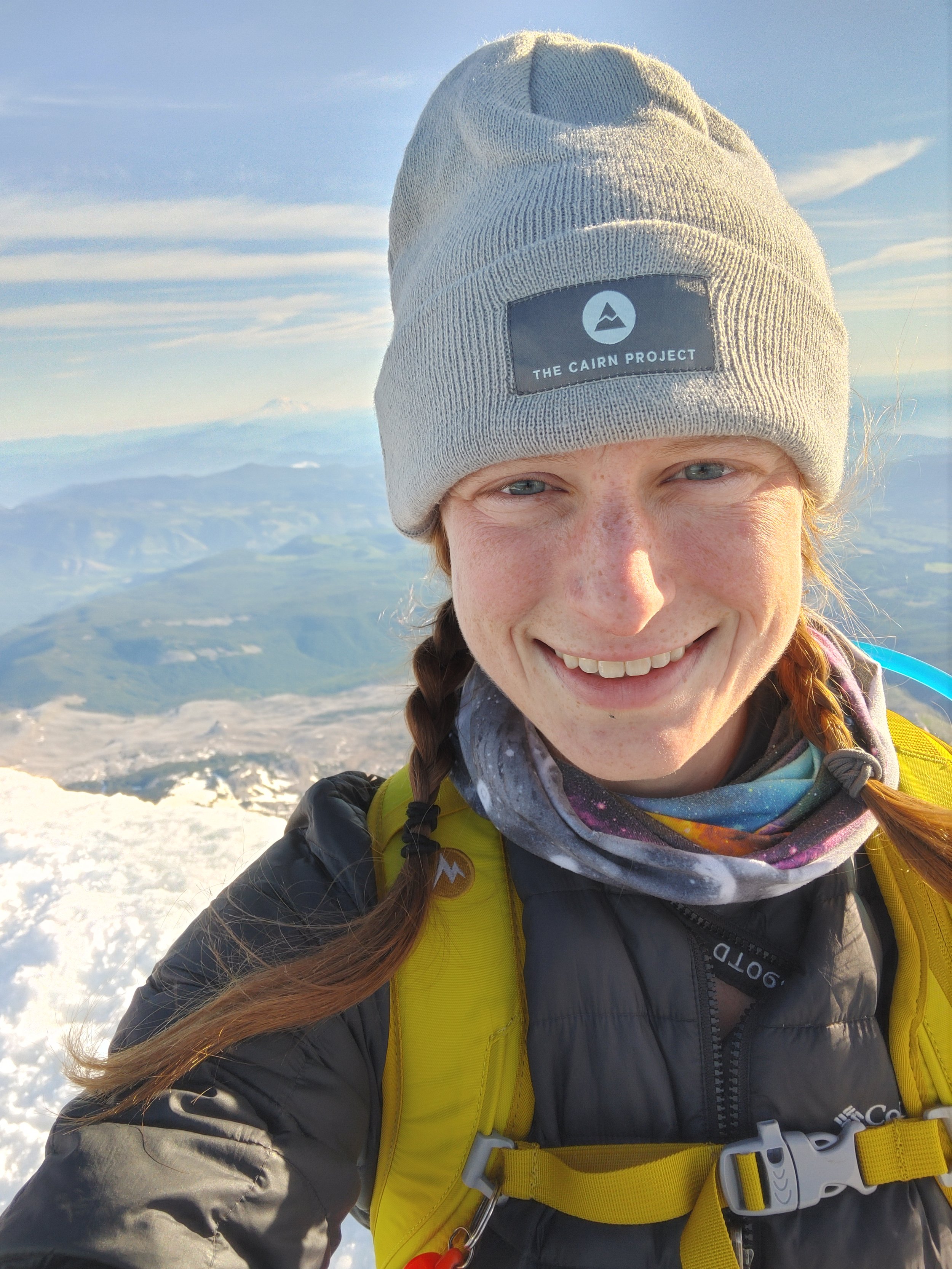
Rocking my Cairn Project hat!
I occupy and recreate on land stolen from the people of the Confederated Tribes of Grand Ronde and Confederated Tribes of Warm Springs. Many of these people call the mountain Wy’east. I am grateful for the stewardship of these people of their beautiful land.
